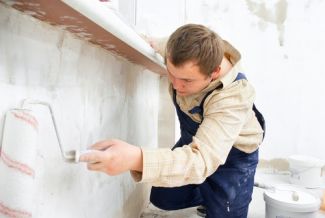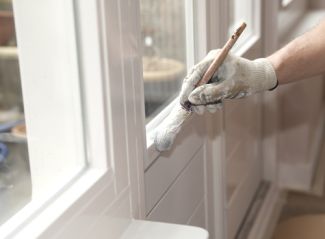Common DIY Painting Mistakes and Professional Tips on Avoiding Them, Part 2

This is a 3-article series, containing a total of 11 DIY painting tips from professional painter Bruce Scofield. Read the whole series to learn how to paint a room like a pro! See the first installment here, painting techniques, part 1. Continuing on, we come to mistake #5…
Mistake #5: Using the wrong amount of paint for the situation.
Why it’s bad: Whether evidenced in blotches, streaks, drips, or ridges - unevenness in paint application is noticeable and never looks good.
Do this instead: Plan on using two coats of finish paint to reach an attractive, even effect. When doing touch-up, it’s always better to paint multiple thin coats than one heavy one, which will leave a ridge. A raw, unfinished surface will absorb more paint than a finished one, so adjust the amount you use accordingly. It takes experience to load your roller or brush with the right amount of paint; too much will cause drips, too little is difficult to spread evenly. Keep your roller wet with paint; do not let it run dry, stretching the paint too far. Add to your efficiency and neatness by keeping your paint supply close by. Never use a larger than quart size container to brush from; it is easy to overload your brush when using a large paint bucket. When masking, make sure you achieve a very good seal with quality painter’s tape and then apply paint sparingly to the tape; otherwise paint is apt to seep under your masking job.
Mistake #6: Not preparing your brush or roller cover for use.
 Why it’s bad: The brush or roller will not accept the proper amount of paint. Paint will tend to wick upward toward the top of your brush where it you do not want it, making the brush hard to clean. New rollers fresh from the package may leave a trail of fuzz on the painted surface.
Why it’s bad: The brush or roller will not accept the proper amount of paint. Paint will tend to wick upward toward the top of your brush where it you do not want it, making the brush hard to clean. New rollers fresh from the package may leave a trail of fuzz on the painted surface.
Do this instead: Dampen your brush then shake out the excess. Wet your roller cover in a sink, run the edge of a putty knife over it to squeeze out the majority of excess water, and then spin the roller, leaving it damp.
Mistake #7: Careless ladder use

Why it’s bad: Misuse of a ladder is a frequent cause of DIY accidents.
Do this instead: Climb a ladder only as far as you are comfortable. Don’t reach out too far. Take the time to make sure the ladder is stable and move it as often as necessary.
Mistake #8: Believing all the advertising in the paint industry.
Why it’s bad: You can needlessly spend extra money for a designer name or the promise of one-coat product.
Do this instead: Keep in mind that the number of coats necessary for the job completely depends on the surface you are painting. Most paints on the market are very similar and any good paint store can mix whatever color you want.
Continue reading in the third and final installment of DIY painting tips from Bruce.
Image source: perspicacious
 The Common DIY Painting Mistakes and Professional Tips on Avoiding Them, Part 2 by Water Damage Defense, is licensed under a Creative Commons Attribution-ShareAlike 3.0 Unported License.
The Common DIY Painting Mistakes and Professional Tips on Avoiding Them, Part 2 by Water Damage Defense, is licensed under a Creative Commons Attribution-ShareAlike 3.0 Unported License.
